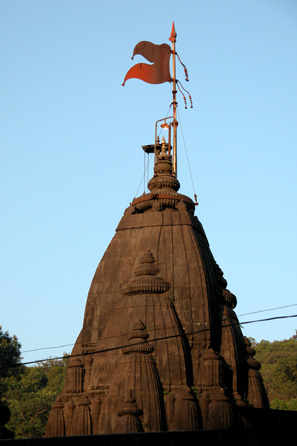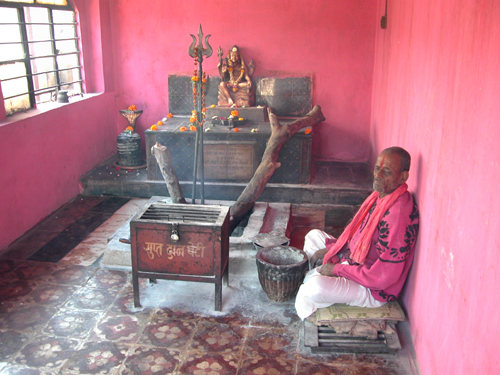 |
The Bhimashankar Jyotir Lingam Temple, Pune area, Maharastra |
|
 |
The Bhimashankar Jyotir Lingam Temple, Pune area, Maharastra |
|
|
|
| The last part of the journey to the Bhimashankar Temple is a walk along numerous steps and shops lining the path to the temple. Here you can buy Prasad, various herbs, medicinal plants, and all the items associated with Puja. The notable difference, from temples in other parts of India, is in the offering of flowers. Because of the inaccessibility of the temple, the usual Marigold is replaced by a beautiful purple wild flower, growing in the area. |

First wiev of the temple tower
| The Bhimashankar Temple | |
 |
|
|
Completely off the beaten track, Bhimashankar can be reached by road from Mumbay
(Vashi Station, 12.30)
after about 7-8 hours drive. The site is a very important pilgrim
place for Hindus, as it is housing one of Maharastras five Jyotir Lingas*. There are no easy accessible way to reach the shrine. During festivals like Shivaratri busses are arranged and numerous pilgrims come visiting this shrine. Crowded with people, long lines of pilgrims snakes down stairs along the railings to the temple. Some pilgrims take a dip in the Mokshakund - an essential absolution before offering worship. There are two idols of Nandideva. One idol is very old, while the other is a fairly recent addition. The Goddess is worshipped here as Kamalaja. The Moola Lingam is at a lower level. |
|
|
|
|
 A rare foto of one of the two the Nandi bulls guarding the Lingam in the Sanctum Santorum |
|
 Serene atmosphere in the temple yard |
|
 Main entrance of the temple |
|
 Puja counter |
|
|
|
|
 The Sikhara in early morning light ... |
 ... and high noon |
|
The Bhimashankar Shiva Linga |
|
|
|
The
Bhimashankarar Shiva Lingam measures around 45cm (1½ foot) and is quite narrow. The top of
the Lingam is divided into two parts by a small groove, symbolizing Parvati and
Gauri Shankar. The Lingam is black and shining, polished over centuries by all the Puja materials that have been poured over it
and numerous worshipping hands. Water is oozing from the Lingam perennially. Some pilgrims take a dip the nearby Teertham - an essential absolution before offering worship. Every day Rudra and Panchamrit Abishekam is performed to the Lingam and the Lord is praised in rich words. |
|
Mythology |
|
This temple is closely associated with the legend of Lord Shiva slaying the demon Tripurasura: In ancient times a demon by the name Tripurasura became drunk with power. He harassed every resident of Swarg (Heavens), Narak (Hell) and Patal (Nether world). The Gods were very scared. Lord Mahadev himself came to destroy Tripurasur. Lord Shankar assumed colossal proportions. Tripurasur feared this Rudraavatar when he saw him. The dual went on for several days. In the end, Lord Shiva killed the wicked demon and set the three worlds, Tribhuvan, free. Lord Shankar, in the form of a huge hunk (Virat), was very tired. In order to get some rest, he settled here on the high area of the Sahyadri mountains. Sweat started pouring down from his huge body in thousands of streams. It all joined together and collected a pond or Kund. The river that started from here is known as Bhima, which can be seen even today. Devotees then prayed to Bhimakaya Rudra thus: "In order to save the good people, please reside here forever!" Bholenath listened to his devotees and stayed there as a Jyotir Linga forever. |

The Bhimarshankar temple top

Weiv to the Sikharas of the Goddess Kamalaya Shrine

Lord Hanuman adorning the temple wall

Shiva shrine with the Homakunda burning

Temple wall at the Homakunda

Tilak paste made of turmeric and kumkum powder
|
Pilgrim shelter in the village near the temple |
|
|
|
|
|
|
|
|
|
|
|
|
|
|
|
|
|
The Sahyadri Hills |
|
|
At about 1000m (3,000 feet), beside the
source of the Bhimarathi river which later merges into the River Krishna, in the
dense unpopulated forests of the Bhimashankar Wild Life Sanctuary, home to wild
boars, sambars, hyenas, porcupines and the occasional leopard, you find the
shrine of one of the 12 Jyotir Lingams. The monsoon showers gives birth to numerous rivulets and waterfalls that falls in abundance amidst the lush green hills. These hills are stark reminders of the Himalayas. The thick veil of mist and the surrounding mountains are deeply reminiscent of some of the well-hidden regions of the Himalayas where worshippers of Lord Shiva seek His darshan. |
|

The Bhimashankar Sikhara in the early morning light
|
The Bhimashankara Temple in Guvahati, Assam |
|
Another temple at Guwahati in Assam is known as the Bhimshankaram Temple. According to the Shiv Purana the Bhimashankar Shrine is situated at the hill of Brahmpura in the Kamroop district of Assam. There is a belief, that this is the real Bhimashankaram.
Bhima was an Asura, son of Kumbakarnan and Karkadi. On hearing that his grandfather, uncles and father had been killed by a Brahmin and kings, he set out to destroy them. He undertook severe penance and got immense might and power from Lord Brahma. King Priyadarman of Kamarupa was also put to prison. Priyadarman and his wife Dakshinadevi prayed sincerely to Lord Shiva everyday. Fearing that they would overcome him, Bhima asked them to stop their prayers. When they refused, he set out to kill them. Lord Shiva rose out of the Lingam that they had been worshipping and slayed Bhima. On the request of the Devas, Lord Shiva resides here under the name Bhimashankarar.
Yet various other sources, describing this ancient shrine, points its situation to be on the mount of the Sahyadri Range in Maharastra. |

OM Namah Shivaya
mukti4u2.dk ► created by BP